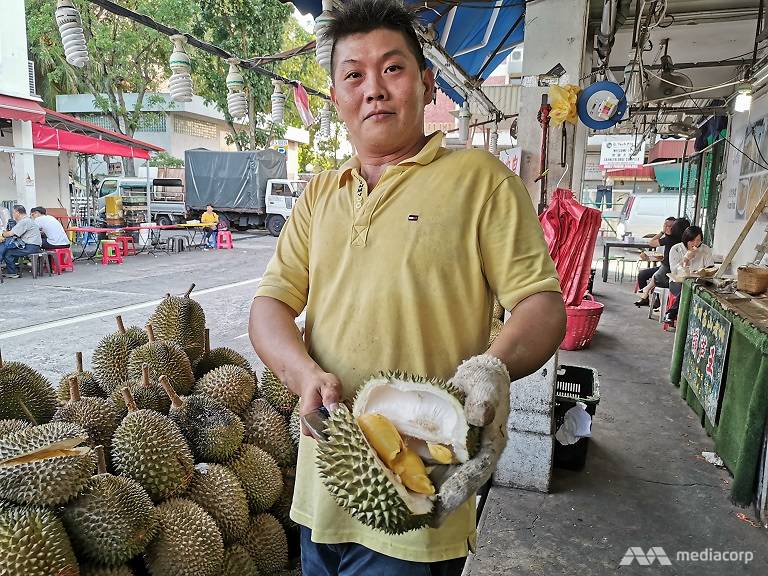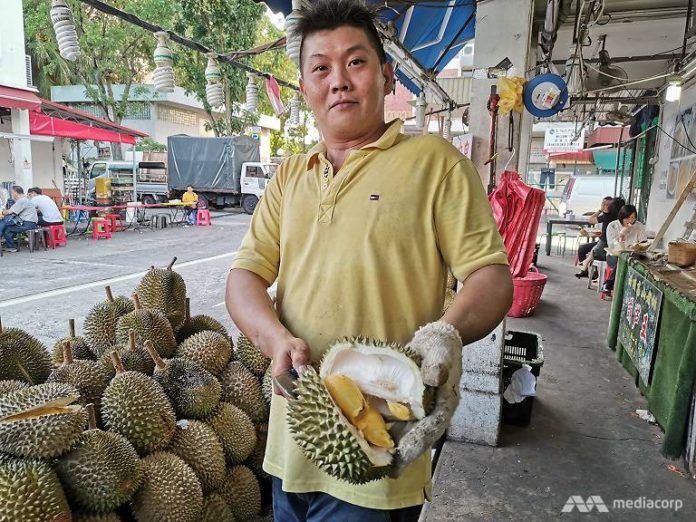SINGAPORE: A distinct pungent smell wafted along Sims Avenue, as the shelves of fruit stalls in the area were stacked with durians on Tuesday afternoon (May 28).
Prices have been slashed during the opening weeks of this year’s durian season, with shops in Singapore selling the famous Musang King, or Mao Shan Wang, variety for as low as S$15 per kg. The same fruits were being sold for double the price around this time last year.
Why the cheaper durians? A bumper crop in Malaysia brought about by favourable weather conditions, as well as weaker demand during Ramadan, said industry players.
The manager of Ah Hung Sultan Durian located along Sims Avenue, who only wanted to be known as Huat, told CNA that the lower prices are “here to stay” this season.
It’s Musang King durians were selling from S$20 per kg upwards on Tuesday, while last year’s price during the same period was at least S$30 per kg.
However, the store remains profitable because of “non-stop supply” from Johor, Pahang and Penang, he said.
He then pulled out a small Musang King durian, which weighed less than a kilogram.
The entire fruit was being sold for around S$8, a price which was “unheard of” in previous years, he said.

This small Musang King durian was selling for S$8, much cheaper than previous years. (Photo: Amir Yusof)
The Musang King durian is popular among customers for its bright yellow flesh and creamy texture.
With a sharp knife, he slit the thorny exterior with one stroke to unveil smooth bright yellow fruit. “We are still expecting more to come from Raub, Pahang, in a few weeks, so maybe the price will drop even more,” he added.
The Musang King, or Mao Shan Wang, durian is popular among customers for its bright yellow flesh and creamy texture. (Photo: Amir Yusof)
Another store along the same stretch – Chin Yong Fruits Trading – was selling Musang King durians from Muar and Pagoh in Johor.
The store manager, who only wanted to be known only as Ah Kim, said some Musang King durians were being sold for S$15 per kg, but the premium “black gold” Mao Shan Wang fruits, were being sold for S$30 per kg.
Ah Kim highlighted that the prices were considered low as compared to 2018, when his durians sold for between S$30 and S$45 per kg during peak season.

This premium Musang King durian was being sold for S$30 per kg. (Photo: Amir Yusof)
“The low prices are attracting people to come. Visitors from the Ramadan bazaar at Geylang Serai will come here after their shopping at night, and there were queues on weekends,” he added.
BUMPER CROP FROM MALAYSIA
Low durian prices are due to an increase in supply from Malaysian plantations as well as weak demand during the Ramadan fasting month, said Ms Melissa Yap, the chairman for Pahang’s fruit farmers’ association.
“It is fasting month, so people living in peninsula Malaysia are not eating durians as much in the day time. Also, good weather means that there has been a bumper crop in many states. A combination of these factors could have led to the lower prices,” she told CNA in a phone interview.
She added that in Raub, Pahang, which is a major growing area, the price of Musang King has dropped from RM50 (S$16.46) per kg last year, to around RM30 this week.

Durian season for Malaysia lasts from May until July. (Photo: Amir Yusof)
Low prices will likely continue throughout this durian season although Ramadan will end next Wednesday, she added.
“The thing is, states like Johor and Penang have produced a bumper crop of Musang King. But in Pahang, which produces tonnes of Musang King, the biggest wave of fruit fall will only come in June. This will boost the supply further to all our exporting countries, including Singapore,” said Ms Yap.
“After the fasting month, people will consume more and this will stabilise the prices and keep it to around RM30 (per kg) for the whole season until July,” she predicted.
THE WEATHER FACTOR
Good weather conditions have played a part.
Durian expert Mr Lim Chin Khee, who owns a small plantation in Raub for R&D purposes, told CNA that this year’s bumper crop for Musang King, and all other durian varieties, across peninsula Malaysia can be attributed to favourable weather conditions. This has also boosted the quality of the fruits produced, he said.

Durian varieties commonly grown in Malaysia. (Image: Facebook/Singapore Food Agency)
“The durians that drop during the dry season, from May to August this year, have benefited from sufficient water earlier to produce durian that are creamier, with stronger aromas,” said the agricultural science graduate from Universiti Putra Malaysia.
He estimated that during this peak season – from May until July – Raub could produce between 30,000 to 50,000 tonnes of durians in total. Despite the surge in supply, he said the current prices of around RM30 per kg for the Musang King variety for this season will soon stabilise.
“In previous years, when prices were high, people complained … but now it’s a good time to eat durian,” he said.





